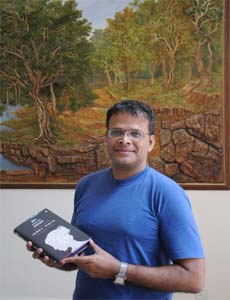Em and the Big Hoom
Jerry Pinto. Aleph, New Delhi. Pages 235. Rs 495.
 SHE called him Mambo, and Augie, but almost never by his given name, Augestine. He called her Imelda, which was her name, and sometimes, Beloved. The author calls her Em and him Hoom. The lived in Bombay, in Mahim in the last decades of the 1900s. They loved each other deeply, and were, in turn, adored by their children.
SHE called him Mambo, and Augie, but almost never by his given name, Augestine. He called her Imelda, which was her name, and sometimes, Beloved. The author calls her Em and him Hoom. The lived in Bombay, in Mahim in the last decades of the 1900s. They loved each other deeply, and were, in turn, adored by their children.
What a love story it was, of Augestine gently courting this beautiful girl for years, nay over a decade, in book shops and other such places where they would be together. They met in their office. He was a man who liked women. He greeted her with a “Hello buttercup”, to which she did not know how to respond.
She had been born in Rangoon, crossed over into India on a ship after the Japanese invaded Burma. He had moved from his village to Poona to take his board exams, and from there he landed up in Bombay, where he became a coolie for a few hours till the station master, a fellow Goan, took care of him. Later, he became a compounder for a doctor, who encouraged him to study and better his prospects.
Imelda’s aunt and godmother decided to force the issue and marched up to the office of Ampersand Smith Limited, where Augestine was the junior manager, sales. They had themselves introduced to the suitor, interviewed him and decided that he would do. Imelda worked hard to improve her position in ASL, an engineering goods company in which she worked as a secretary. She gave all that she earned to her mother, without saving anything for herself.
Imelda and Augestine married. They had children, yet the Mendeses were not a conventional family, simply because she was afflicted with bipolar disorder, the shadow of which affected everybody around her. Em and the Big Hoom brings to us a world which is intimate even as it is different. The story, which took a long time to finally be seen in print, takes us beyond our comfort zone into the world of his mother, who became mentally challenged.
Imelda’s world became the one-bedroom-hall-kitchen in Mahim, where her husband, son and daughter lived; and the various hospitals, especially JJ Hospital’s Ward 33, where she would regularly go for treatment.
Pinto has captured the light and darkness of a bipolar existence with rare sensitivity and felicity. In fact, the structure of the book and the way in which he weaves in Imelda’s memories with episodes of depression and other incidents take the reader into Imelda’s mind and also capture her tenuous hold on reality even as she struggles with the fact that the synapses of her brain are not functioning properly.
Pinto has a wide repertoire as a writer. He has been a mathematics tutor, a journalist, a freelancer, magazine editor and has many books to his credit, including the bestseller Surviving Women and Helen: The Life and Times of an H Bomb which won the National Award for the Best Book on Cinema. He has also published books on poetry. In this book, we see the sum and experience of all his writing. He combines the sensitivity of a poet that he is, with the deep empathy of a son who cares for the mother he dearly loves, even as she is gradually losing touch with reality and escaping into a world of her own from time to time. This is a moving book, one that stays with the reader for a long time after the cover has been closed.
This review by Roopinder Singh was published in The Tribune on June 17, 2012
